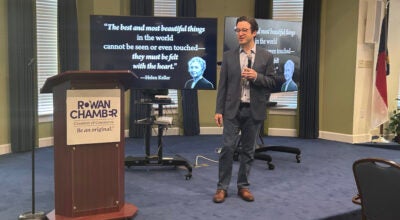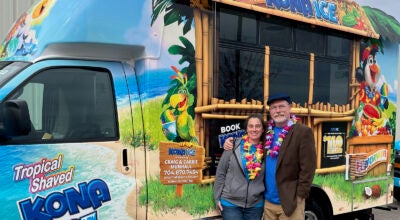Research campus moving past slow start, looking to define future
Published 12:10 am Sunday, March 8, 2015

- JON C. LAKEY / SALISBURY POST Glenn Carroll and Joshua Pinyan take part in a study in the Appalachian State University Human Performance Lab on the North Carolina Research Campus in Kannapolis. The two runners are part of study that required them to run on treadmills for two hours.
The N.C. Research Campus still lags behind initial employment projections, but, as the nation and state recover from an economic recession, growth is beginning to pick up.
Following billionaire businessman David Murdock’s $15 million annual endowment last year, the research campus aims to expand and the David H. Murdock Research Institution is looking to refocus on its initial intent — becoming a world class research institution. The catchphrase being used to define the future of the facility is “putting the RI back in DHMRI.”
President and CEO of real estate development company Castle and Cooke Lynne Safrit mentioned a few areas — cancer, neurodegenerative disease and diabetes — as potential, future focus areas for the David H. Murdock Research Institution, which is housed on the N.C. Research Campus.
From the beginning
Before Murdock could even dream of creating a world-class research institution, the land that currently houses the research campus was home to Cannon Mills — founded in the late 1880s. Kannapolis — initially a village for mill workers — was decades way from being incorporated.
As the mill’s employment grew, so did the population of the village. It’s estimated that at its peak Cannon Mills was the largest producer of towels in the world, employing 25,000 people.
Ownership changed, but the mill facility kept chugging along until 2003.
Bankruptcy by the mill’s ownership group Pillowtex led to a single, swift announcement that resulted in thousands of people losing their jobs in one day. The mass of layoffs was compared to a natural disaster. Suddenly, the mill that created Kannapolis was the reason for thousands simultaneously being unemployed.
One year later, Murdock purchased the shuttered and abandoned Plant One for $6.4 million. He announced the N.C. Research Campus in 2005. Initial employment projections were for thousands of people within several years of its opening. A “ripple effect” from the campus was, likewise, expected to create a whorde of jobs in the community, Safrit said.
In 2006, several parts of the mill were destroyed. It was an initial sign of the research campus’ potential benefits for the town, said Kannapolis Mayor Darrell Hinnant.
“The plant would’ve been a white elephant,” Hinnant said. “What would you do with something that’s bigger than the Pentagon?”
Starting off
Shortly after the research campus opened, welcoming a conglomerate of universities from around the state, the U.S. fell into an economic crisis that touched every part of society. The research campus, likewise, suffered from the recession. Grant funding became more difficult to secure. Companies such as PepsiCo and PPD, a contract research organization based in Wilmington, left.
Business growth was slower than expected, but the campus’ Vice President of Business Development Clyde Higgs contends the Kannapolis facility still fared better than other research institutions.
“The recession hit everyone hard, and we were no exception to that,” Higgs said. “But, for people that don’t really understand how these developments take place it’s easy to say ‘oh things went a little slower than normal.’ We may have been going slower than normal, but we were going at such a lightning pace compared to any other research park.”
Currently, Higgs said the research campus’ employment numbers are just under 1,100 people — below initial projections.
The latest available filing from the non-profit DHMRI to the IRS also shows financials lagging behind. In the fiscal year ending June 30, 2013, total revenue at DHMRI was $11.4 million. Expenses were $15.9 million.
The figures don’t include the annual endowment by Murdock in fall 2014, which Safrit said would allow DHMRI to conduct world class research. Based on 2013 financials alone, Murdock’s $15 million annual endowment is more than double annual revenues. The endowment may have been the much-needed catalyst for change and development researchers were looking for.
Methods for growth
A large portion of the initial work done, or at least more than desired, at the campus was contract research, said interim DHMRI President John Cavanagh. A company, for example, would pay researchers money to test out its product. The contract research may have brought in money, but Cavanagh said DHMRI wasn’t able to establish its own research identity.
Murdock’s contribution last year will provide the base for DHMRI to expand the scope of its research. Contract work may always be a part of DHMRI, but Cavanagh hopes to focus on specific diseases as a part of research conducted at the Kannpolis facility. He’s proposing scientists focus on cancer, cardiovascular disease, diabetes, inflammatory diseases and neurodegenerative diseases.
Part of the formula for growth, he said, would be monetary — grants and outside investment. Another part will be bringing in top-notch researchers.
“What I really like is that we’re seeing some growth again across the whole campus, but we need more people to help with that growth,” Cavanagh said.
Some growth may not be externally visible, such as additional hires. Higgs said a majority of the available space at the research campus is leased. Some leased space, he said, is not filled to capacity, meaning new hires won’t immediately lead to additional building space being leased.
Construction work at the facility is taking place both externally and internally. One example includes A North Carolina Agriculture and Technical State University expansion into the core laboratory building. N.C. A&T will lease an entire suite in the core building to alleviate crowding in their 5,800 square feet laboratory and office suite, located in the UNC Nutrition Research Institute Building. The NCA&T core lab facility is expected to be fully operational by April.
Duke University is also expanding its footprint at the research campus to make room for tech giant Google’s Baseline Study. Duke would use 5,000 square feet of office space with four exam rooms in the Medical Office Building on the campus starting in July. Stanford is another site for Google’s study. However, Duke officials have been tight-lipped about exact details about Google’s intentions.
Safrit said landing large business partnerships could, in turn, help with DHMRI defining its future.
“It takes a lot of money to do this kind of research,” Safrit said. Obviously, the low-hanging fruit is to do work for others and be paid for it at DHMRI. That’s good, and we want to continue to do that, but we want to be able to really prove that we’re doing important research.”
Already in progress
With millions more flowing into the research campus annually from Murdock, the future may be bright, but many of the researchers at the campus can easily list a memorable study that’s occurred at the facility. Cavanagh easily recalled one that involved Dr. David Nieman, the director of Appalachian State’s operations at the research campus.
Nieman’s research in 2012 revealed that bananas were, in many ways, better than sports drinks during intense cycling. Cyclists consumed either a small amount of sports drink or half a banana every 15 minutes during a simulated road race over the course of multiple hours.
The study found bananas provided the cyclists with antioxidants not found in sports drinks as well as a greater nutritional boost.
Nieman mentioned a study that resulted in increased metabolism after 45 minutes of heavy exertion. The research found that 37 percent more calories were expended after the exercise. It was an “after-burn effect,” Nieman said.
“We’ve made great research discoveries because of the industry, university collaborations that are available and sophisticated technology for measurement,” Nieman said.
As a sign of the value of the campus’ location and tenants, Nieman said the amount of industry funding brought into Appalachian State’s Kannapolis lab would’ve been nearly impossible to do in Boone, where the university’s main campus is located.
The researchers in Appalachian State’s lab are currently working to see the exact affect of a company’s sports drink on muscle recovery. Study participants run on a treadmill at a continuous pace for an extended period of time. A series of measurements are taken afterward.
Nieman and others say the simple fact that so many researchers are located within walking distance of each other makes significant collaborations easier.
And, it’s those scientific collaborations that may already be Kannapolis’ greatest asset, just over a decade after an industry that, at one point, employed more people than most small cities, went bankrupt.
“We believe that the future of Kannapolis and the future of the research campus are integrally related,”Hinnant said. “It is still a boon to our region and it is going to be, in the long run, one of the best investments North Carolina has ever made.”
Contact reporter Josh Bergeron at 704-797-4246.




